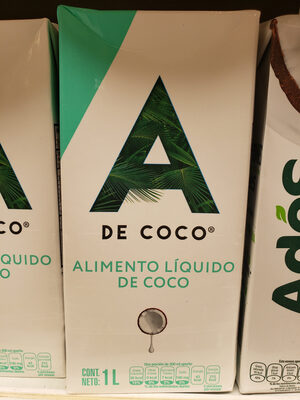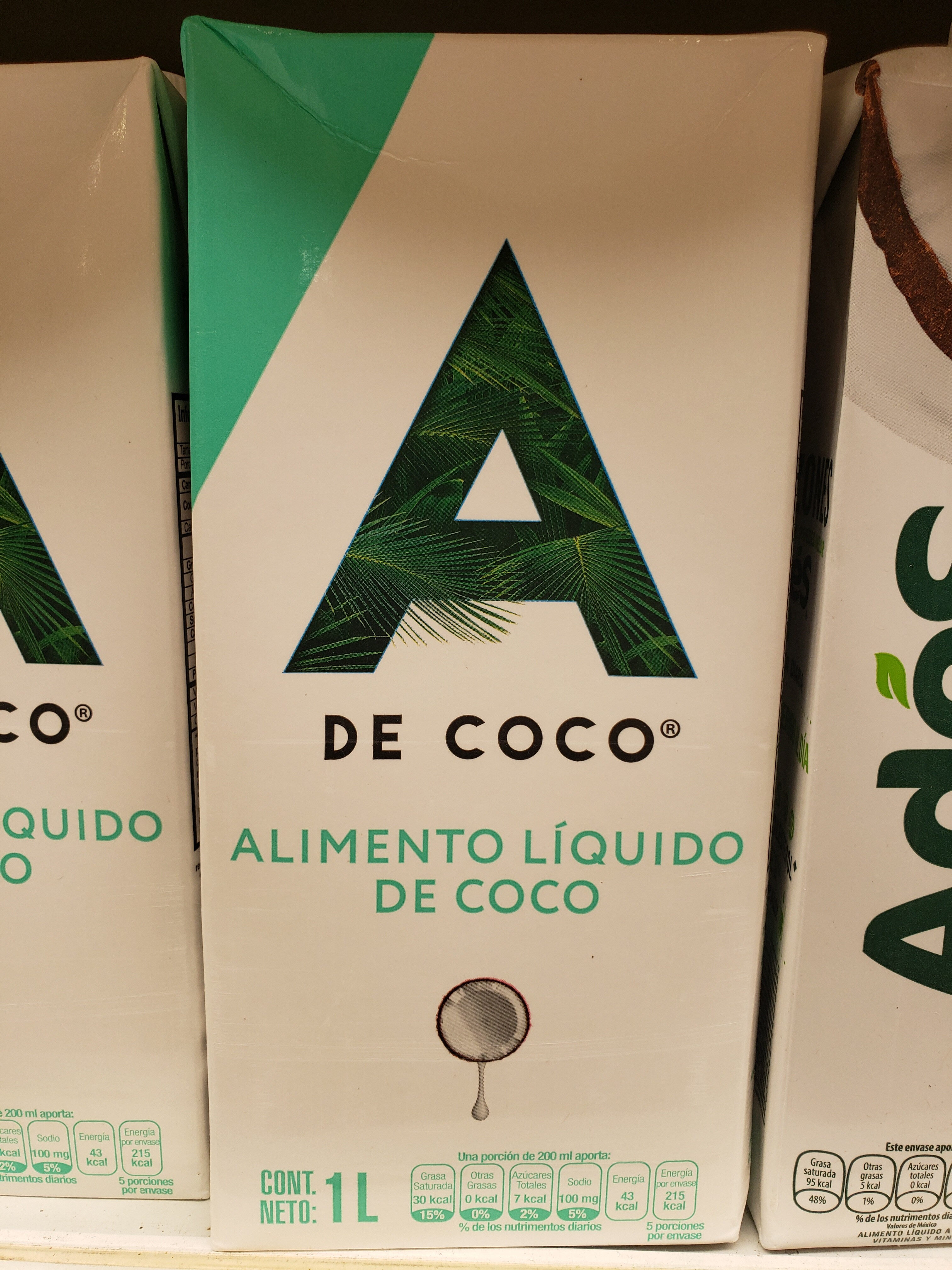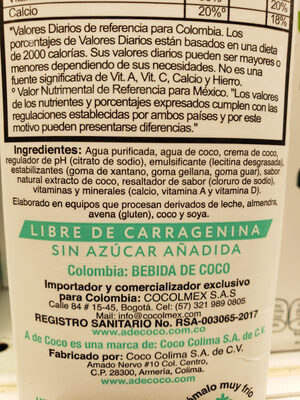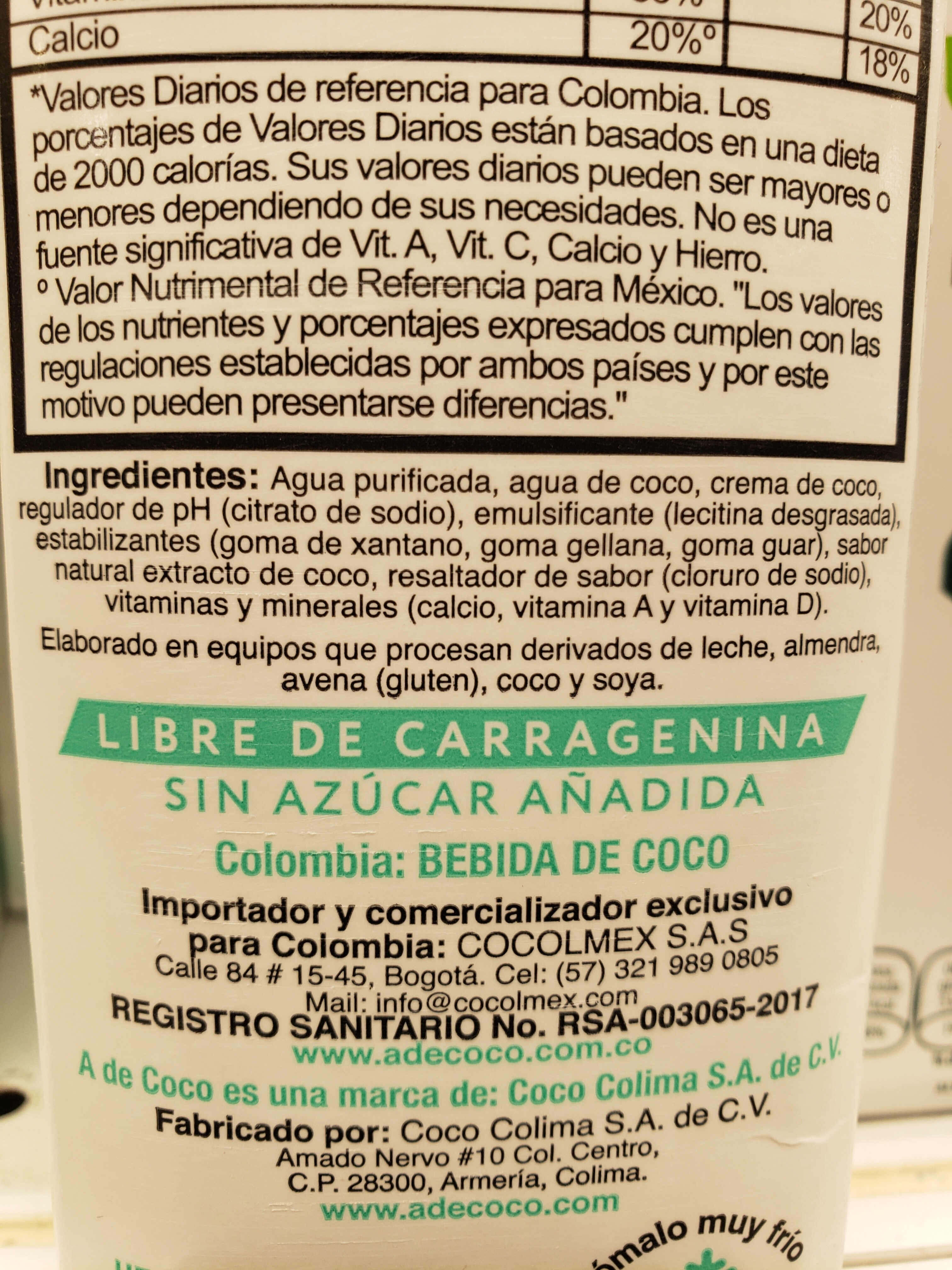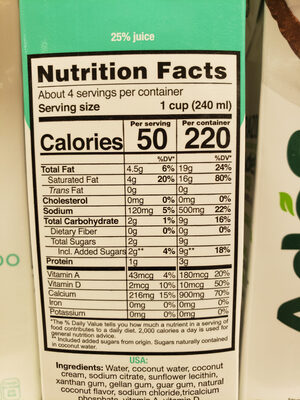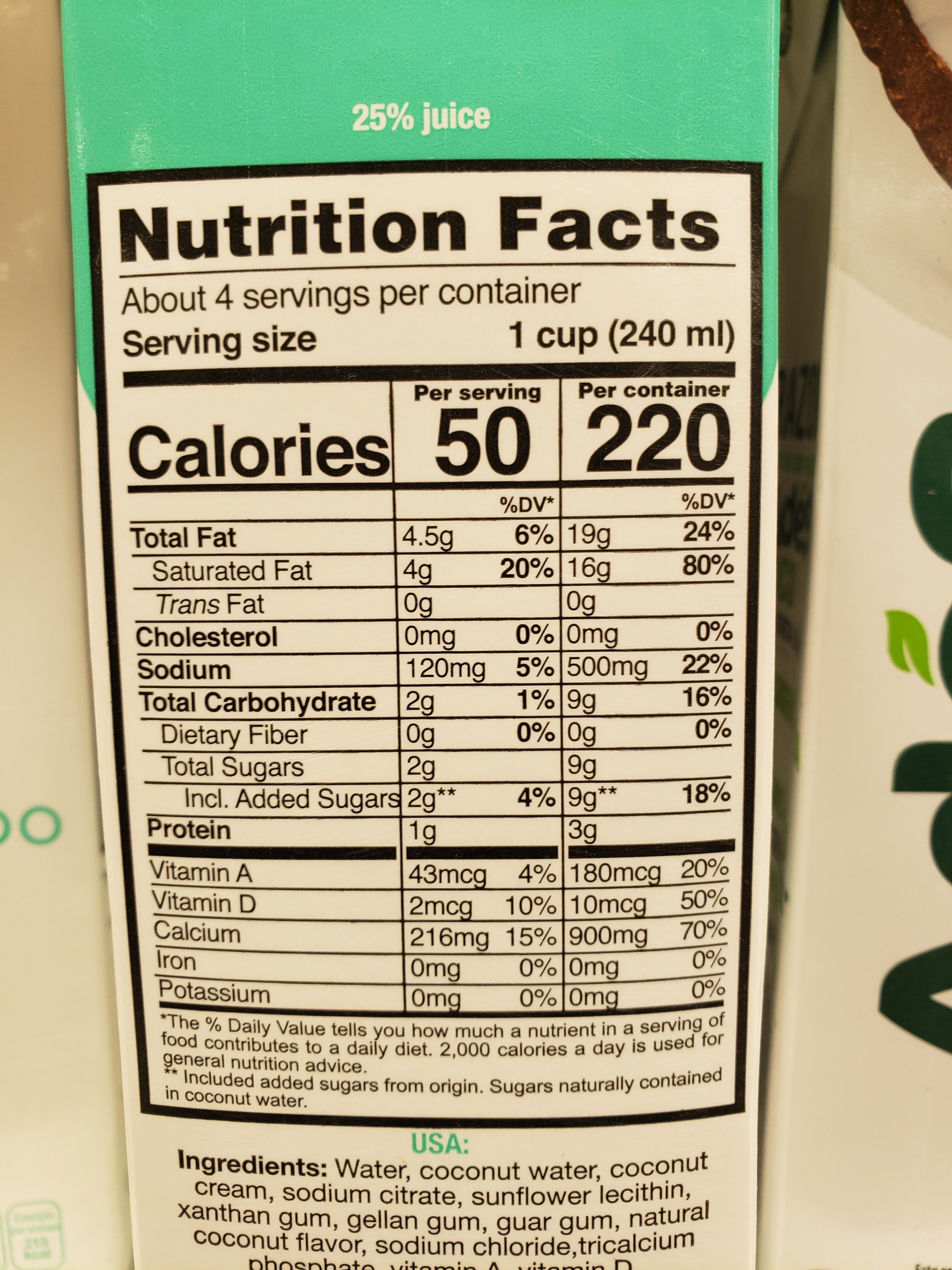Help us make food transparency the norm!
As a non-profit organization, we depend on your donations to continue informing consumers around the world about what they eat.
The food revolution starts with you!
Alimento Líquido de Coco - A de Coco - 1 l
Alimento Líquido de Coco - A de Coco - 1 l
This product page is not complete. You can help to complete it by editing it and adding more data from the photos we have, or by taking more photos using the app for Android or iPhone/iPad. Thank you!
×
Barcode: 7503008669055 (EAN / EAN-13)
Common name: alimento liquido de coco
Quantity: 1 l
Packaging: Tetra Pak
Brands: A de Coco
Brand owner: A DE COCO
Categories: Plant-based foods and beverages, Beverages, Plant-based beverages, Coconut waters, Alimento-liquido
Origin of ingredients: Mexico
Manufacturing or processing places: Armería, Colima
Countries where sold: Mexico, United States
Matching with your preferences
Health
Ingredients
-
13 ingredients
Water, 25% coconut water, 2,5% coconut pulp, nonfat lecithin, sodium citrate, xanthan gum, guar gum,gellan gum, sodium chloride, natural coconut flavor, tricalcium phosphate, vitamin a, vitamin d3.Traces: es:elaborado-en-equipos-que-procesan-derivados-de-leche-y-soya
Food processing
-
Ultra processed foods
Elements that indicate the product is in the 4 - Ultra processed food and drink products group:
- Additive: E322 - Lecithins
- Additive: E415 - Xanthan gum
Food products are classified into 4 groups according to their degree of processing:
- Unprocessed or minimally processed foods
- Processed culinary ingredients
- Processed foods
- Ultra processed foods
The determination of the group is based on the category of the product and on the ingredients it contains.
Additives
-
E322 - Lecithins
Lecithins are natural compounds commonly used in the food industry as emulsifiers and stabilizers.
Extracted from sources like soybeans and eggs, lecithins consist of phospholipids that enhance the mixing of oil and water, ensuring smooth textures in various products like chocolates, dressings, and baked goods.
They do not present any known health risks.
-
E322i - Lecithin
Lecithins are natural compounds commonly used in the food industry as emulsifiers and stabilizers.
Extracted from sources like soybeans and eggs, lecithins consist of phospholipids that enhance the mixing of oil and water, ensuring smooth textures in various products like chocolates, dressings, and baked goods.
They do not present any known health risks.
-
E331 - Sodium citrates
Sodium citrate: Sodium citrate may refer to any of the sodium salts of citrate -though most commonly the third-: Monosodium citrate Disodium citrate Trisodium citrateThe three forms of the salt are collectively known by the E number E331. Sodium citrates are used as acidity regulators in food and drinks, and also as emulsifiers for oils. They enable cheeses to melt without becoming greasy.Source: Wikipedia
-
E415 - Xanthan gum
Xanthan gum (E415) is a natural polysaccharide derived from fermented sugars, often used in the food industry as a thickening and stabilizing agent.
This versatile food additive enhances texture and prevents ingredient separation in a wide range of products, including salad dressings, sauces, and gluten-free baked goods.
It is considered safe for consumption even at high intake amounts.
Ingredients analysis
-
Palm oil free
No ingredients containing palm oil detected
Unrecognized ingredients: es:gomas-xantana-gellana-y-guar, es:sabor-coco-naturalSome ingredients could not be recognized.
We need your help!
You can help us recognize more ingredients and better analyze the list of ingredients for this product and others:
- Edit this product page to correct spelling mistakes in the ingredients list, and/or to remove ingredients in other languages and sentences that are not related to the ingredients.
- Add new entries, synonyms or translations to our multilingual lists of ingredients, ingredient processing methods, and labels.
If you would like to help, join the #ingredients channel on our Slack discussion space and/or learn about ingredients analysis on our wiki. Thank you!
-
Vegan status unknown
Unrecognized ingredients: Sodium citrate, es:gomas-xantana-gellana-y-guar, Sodium chloride, es:sabor-coco-naturalSome ingredients could not be recognized.
We need your help!
You can help us recognize more ingredients and better analyze the list of ingredients for this product and others:
- Edit this product page to correct spelling mistakes in the ingredients list, and/or to remove ingredients in other languages and sentences that are not related to the ingredients.
- Add new entries, synonyms or translations to our multilingual lists of ingredients, ingredient processing methods, and labels.
If you would like to help, join the #ingredients channel on our Slack discussion space and/or learn about ingredients analysis on our wiki. Thank you!
-
Vegetarian status unknown
Unrecognized ingredients: Sodium citrate, es:gomas-xantana-gellana-y-guar, Sodium chloride, es:sabor-coco-naturalSome ingredients could not be recognized.
We need your help!
You can help us recognize more ingredients and better analyze the list of ingredients for this product and others:
- Edit this product page to correct spelling mistakes in the ingredients list, and/or to remove ingredients in other languages and sentences that are not related to the ingredients.
- Add new entries, synonyms or translations to our multilingual lists of ingredients, ingredient processing methods, and labels.
If you would like to help, join the #ingredients channel on our Slack discussion space and/or learn about ingredients analysis on our wiki. Thank you!
-
Details of the analysis of the ingredients
We need your help!
Some ingredients could not be recognized.
We need your help!
You can help us recognize more ingredients and better analyze the list of ingredients for this product and others:
- Edit this product page to correct spelling mistakes in the ingredients list, and/or to remove ingredients in other languages and sentences that are not related to the ingredients.
- Add new entries, synonyms or translations to our multilingual lists of ingredients, ingredient processing methods, and labels.
If you would like to help, join the #ingredients channel on our Slack discussion space and/or learn about ingredients analysis on our wiki. Thank you!
es: Leche de coco (agua, crema de coco), agua de coco, lecitina, citrato de sodio, gomas xantana gellana y guar, cloruro de sodio, sabor coco natural, fosfato tricálcico, vitaminas, vitamina A, vitamina D3- Leche de coco -> en:coconut-milk - vegan: yes - vegetarian: yes - ciqual_food_code: 18041 - percent_min: 9.09090909090909 - percent_max: 100
- agua -> en:water - vegan: yes - vegetarian: yes - ciqual_food_code: 18066 - percent_min: 4.54545454545455 - percent_max: 100
- crema de coco -> en:coconut-cream - vegan: yes - vegetarian: yes - ciqual_food_code: 18041 - percent_min: 0 - percent_max: 50
- agua de coco -> en:coconut-water - vegan: yes - vegetarian: yes - ciqual_food_code: 18011 - percent_min: 0 - percent_max: 50
- lecitina -> en:e322i - vegan: maybe - vegetarian: maybe - percent_min: 0 - percent_max: 33.3333333333333
- citrato de sodio -> en:sodium-citrate - percent_min: 0 - percent_max: 25
- gomas xantana gellana y guar -> es:gomas-xantana-gellana-y-guar - percent_min: 0 - percent_max: 20
- cloruro de sodio -> en:sodium-chloride - percent_min: 0 - percent_max: 16.6666666666667
- sabor coco natural -> es:sabor-coco-natural - percent_min: 0 - percent_max: 14.2857142857143
- fosfato tricálcico -> en:e341iii - vegan: yes - vegetarian: yes - percent_min: 0 - percent_max: 12.5
- vitaminas -> en:vitamins - vegan: yes - vegetarian: yes - percent_min: 0 - percent_max: 11.1111111111111
- vitamina A -> en:vitamin-a - vegan: yes - vegetarian: yes - percent_min: 0 - percent_max: 10
- vitamina D3 -> en:cholecalciferol - vegan: maybe - vegetarian: maybe - percent_min: 0 - percent_max: 9.09090909090909
Nutrition
-
Good nutritional quality
⚠ ️Warning: the amount of fruits, vegetables and nuts is not specified on the label, it was estimated from the list of ingredients: 77This product is considered a beverage for the calculation of the Nutri-Score.
Positive points: 4
- Proteins: 0 / 5 (value: 0.5, rounded value: 0.5)
- Fiber: 0 / 5 (value: 0, rounded value: 0)
- Fruits, vegetables, nuts, and colza/walnut/olive oils: 4 / 10 (value: 77.2727272727273, rounded value: 77.3)
Negative points: 5
- Energy: 3 / 10 (value: 87, rounded value: 87)
- Sugars: 1 / 10 (value: 0.8, rounded value: 0.8)
- Saturated fat: 1 / 10 (value: 1.7, rounded value: 1.7)
- Sodium: 0 / 10 (value: 0, rounded value: 0)
The points for proteins are counted because the negative points are less than 11.
Nutritional score: (5 - 4)
Nutri-Score:
-
Nutrient levels
-
Fat in moderate quantity (1.9%)
What you need to know- A high consumption of fat, especially saturated fats, can raise cholesterol, which increases the risk of heart diseases.
Recommendation: Limit the consumption of fat and saturated fat- Choose products with lower fat and saturated fat content.
-
Saturated fat in moderate quantity (1.7%)
What you need to know- A high consumption of fat, especially saturated fats, can raise cholesterol, which increases the risk of heart diseases.
Recommendation: Limit the consumption of fat and saturated fat- Choose products with lower fat and saturated fat content.
-
Sugars in low quantity (0.8%)
What you need to know- A high consumption of sugar can cause weight gain and tooth decay. It also augments the risk of type 2 diabetes and cardio-vascular diseases.
Recommendation: Limit the consumption of sugar and sugary drinks- Sugary drinks (such as sodas, fruit beverages, and fruit juices and nectars) should be limited as much as possible (no more than 1 glass a day).
- Choose products with lower sugar content and reduce the consumption of products with added sugars.
-
Salt in low quantity (0%)
What you need to know- A high consumption of salt (or sodium) can cause raised blood pressure, which can increase the risk of heart disease and stroke.
- Many people who have high blood pressure do not know it, as there are often no symptoms.
- Most people consume too much salt (on average 9 to 12 grams per day), around twice the recommended maximum level of intake.
Recommendation: Limit the consumption of salt and salted food- Reduce the quantity of salt used when cooking, and don't salt again at the table.
- Limit the consumption of salty snacks and choose products with lower salt content.
-
-
Nutrition facts
Nutrition facts As sold
for 100 g / 100 mlAs sold
per serving (1 cup (240 ml))Compared to: Coconut waters Energy 87 kj
(20 kcal)209 kj
(50 kcal)-3% Fat 1.9 g 4.56 g +92,133% Saturated fat 1.7 g 4.08 g Trans fat 0 g 0 g Cholesterol 0 mg 0 mg Salt 0 g 0 g -100% Carbohydrates 0.8 g 1.92 g -85% Fiber 0 g 0 g -100% Sugars 0.8 g 1.92 g -82% Proteins 0.5 g 1.2 g +8,030% Vitamin A 2.1 µg 5.04 µg Vitamin C (ascorbic acid) 1.2 mg (2 % DV) 2.88 mg -62% Calcium 72 mg 173 mg +336% Iron 0.08 mg 0.192 mg +15% Potassium 76 mg 182 mg -58% Magnesium 4 mg 9.6 mg -59% Fruits‚ vegetables‚ nuts and rapeseed‚ walnut and olive oils (estimate from ingredients list analysis) 77.273 % 77.273 % Vitamina-d3 35 % DV (35 % DV) 84 % DV
Environment
-
Eco-Score D - High environmental impact
The Eco-Score is an experimental score that summarizes the environmental impacts of food products.→ The Eco-Score was initially developped for France and it is being extended to other European countries. The Eco-Score formula is subject to change as it is regularly improved to make it more precise and better suited to each country.Life cycle analysis
-
Average impact of products of the same category: C (Score: 45/100)
Category: Coconut water
Category: Coconut water
- PEF environmental score: 0.17 (the lower the score, the lower the impact)
- including impact on climate change: 1.12 kg CO2 eq/kg of product
Stage Impact Agriculture
63.6 %Processing
6.2 %Packaging
5.8 %Transportation
22.2 %Distribution
2.3 %Consumption
0.0 %
Bonuses and maluses
-
Origins of ingredients with a high impact
Malus: -3
Environmental policy: -3
Transportation: 0
Origin of the product and/or its ingredients % of ingredients Impact Mexico 100 %High
-
Packaging with a low impact
Malus: -4
Shape Material Recycling Impact Brick Tetra Pak Medium
Eco-Score for this product
-
Impact for this product: D (Score: 38/100)
Product: Alimento Líquido de Coco - A de Coco - 1 l
Life cycle analysis score: 45
Sum of bonuses and maluses: -7
Final score: 38/100
-
Carbon footprint
-
Equal to driving 0.6 km in a petrol car
112 g CO² per 100g of product
The carbon emission figure comes from ADEME's Agribalyse database, for the category: Coconut water (Source: ADEME Agribalyse Database)
Stage Impact Agriculture
45.4 %Processing
11.9 %Packaging
8.9 %Transportation
32.5 %Distribution
1.2 %Consumption
0.0 %
Packaging
-
Packaging with a low impact
-
Packaging parts
Brick (Tetra Pak)
-
Packaging materials
Material % Packaging weight Packaging weight per 100 g of product
-
Transportation
-
Origins of ingredients
Origins of ingredients with a high impact
Origin of the product and/or its ingredients % of ingredients Impact Mexico 100 %High
Report a problem
-
Incomplete or incorrect information?
Category, labels, ingredients, allergens, nutritional information, photos etc.
If the information does not match the information on the packaging, please complete or correct it. Open Food Facts is a collaborative database, and every contribution is useful for all.
Data sources
Product added on by openfoodfacts-contributors
Last edit of product page on by bytes2000.
Product page also edited by kiliweb, openfoodfactsmx, openfoodfactsmx4, org-database-usda, packbot, yuka.sY2b0xO6T85zoF3NwEKvlkVbC_-GiR6YNz3ntnbb4PClB7XkRtd5v5jFAas.
